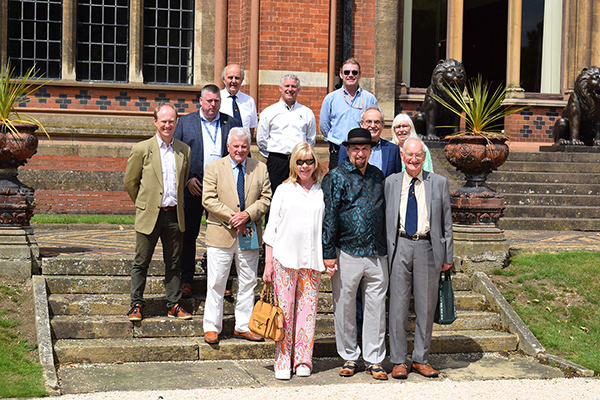
Stewart Davies, the financier who rescued the Grade I listed Kelham Hall in Nottinghamshire when it became a casualty of Covid in 2021, paid the Hall a flying visit (literally) on 13 July with a group of friends that included Martin Robins, a now retired Director of Farmington quarry, which Stewart Davies also rescued in the 1990s.
Martin Robins now lives in the Cotswolds and Stewart Davies flew Martin and his friends from the West Country in his private jet and on to Kelham Hall in helicopters, one of them piloted by Stewart himself. The party included Charlie Laing, the great-grandson of Sir John Laing; Michael Grey, a conservation architect; George Watkins, a retired aeronautical engineer with aircraft components manufacturer Rotol, which supplied the Dowty Group where Martin once worked; and John Mustoe, a retired Cotswold builder. Natural Stone Specialist was also there.

Set in 42 acres, Kelham Hall was built by George Gilbert Scott, before he was knighted for the Albert Memorial in London. Gothic and classical architecture rivalled each other in the mid-19th century and Scott favoured Gothic. He built several Gothic churches in the East Midlands but maintained that the style was also suitable for secular buildings and set about demonstrating that at Kelham Hall, built between 1859 and 1861.
Although Kelham Hall was criticised by Pevsner and Girouard, it was admired by many and became the intellectual justification and model for George Gilbert Scott's St Pancras Chambers in front of St Pancras railway station in London, which, like Kelham Hall, has walls of brick but incorporates a great deal of decorative and structural stonework, including a variety of marble and granites.

Kelham Hall was never quite finished because, having spent £50,000 on it, the family having it built decided they had spent enough. Consequently, some of the decorative marble and granite columns have never been installed (although the stone bases and capitals are ready to receive them) and niches, presumably intended to carry carvings, perhaps of family members, stand empty (see photo above).

Although a variety of stones have been used at Kelham Hall, especially for the mantles of fireplaces and for those columns that have been included (granites, French and Italian marbles, and at least one instance of Purbeck Marble), most of the stonework is Anston, the same stone from Yorkshire used to build the Palace of Westminster.

The Hall was eventually taken over by an Anglican religious order, the Society of the Sacred Mission, which added a substantial extension to the Hall for members of the order to live in. Those rooms are being turned into 52 rooms to accommodate the wedding parties and business groups that hire Kelham Hall now it is an understandably popular destination for such events.
The religious order also built a chapel, which has the second largest dome in England after St Paul’s Cathedral (it claims to be the largest herringbone dome).
When the Society of the Sacred Mission decided it could no longer justify the expense of running Kelham Hall, Newark & Sherwood District Council moved in, dividing the interior with a variety of stud walls and mezzanine levels to create offices, fortunately without causing much damage to the underlying fabric or painting over Scott’s original paint and paper colour scheme. The council additions have now been largely removed on the ground floor, returning the Hall to Scott’s original designs. On upper levels, more work is required to remove the evidence of the council’s occupation.
Scott liked fireplaces, both as a focus for rooms and because he thought the evolving idea of central heating was just a fad. At both Kelham Hall and St Pancras, all the rooms have fireplaces, with the chimney stacks on the roofs adding to the decorative gothic skyline that the buildings create.

All those involved on 13 July thoroughly enjoyed the delightfully convivial and interesting visit. As Charlie Laing said later: “The jet was amazing, the helicopter was amazing, the main house was amazing, the monk's additions were amazing, the garden was amazing, the company was amazing, lunch was amazing, the weather was amazing! Just totally dazed!”
- Kelham Hall stands next to the River Trent and has also just been visited by Bob Mortimer and Paul Whitehouse, whose Gone Fishing TV programme has gained a wide following. They recorded an episode of the programme at the Hall, although it will not be on television until July next year, when the season is again appropriate.

